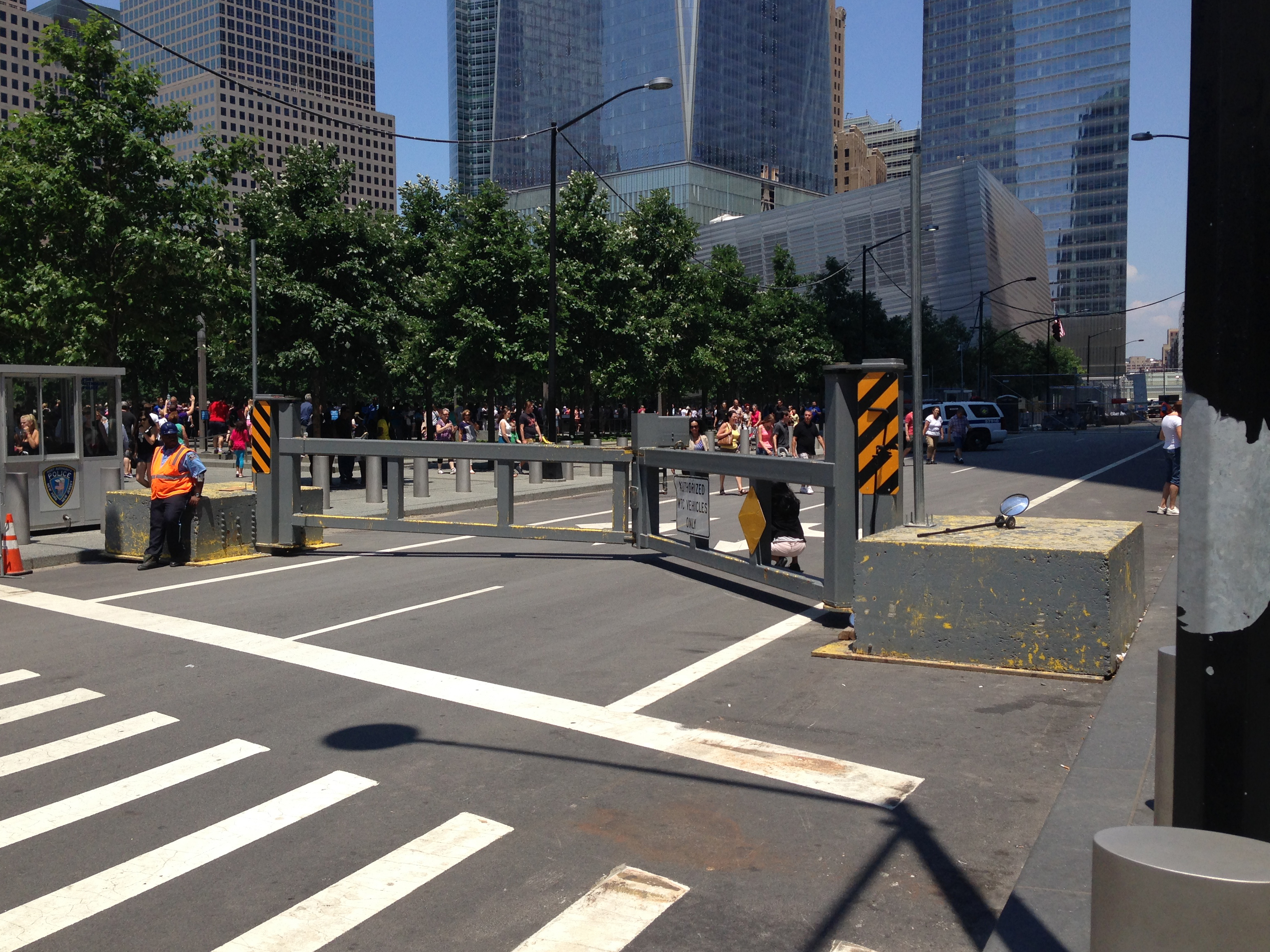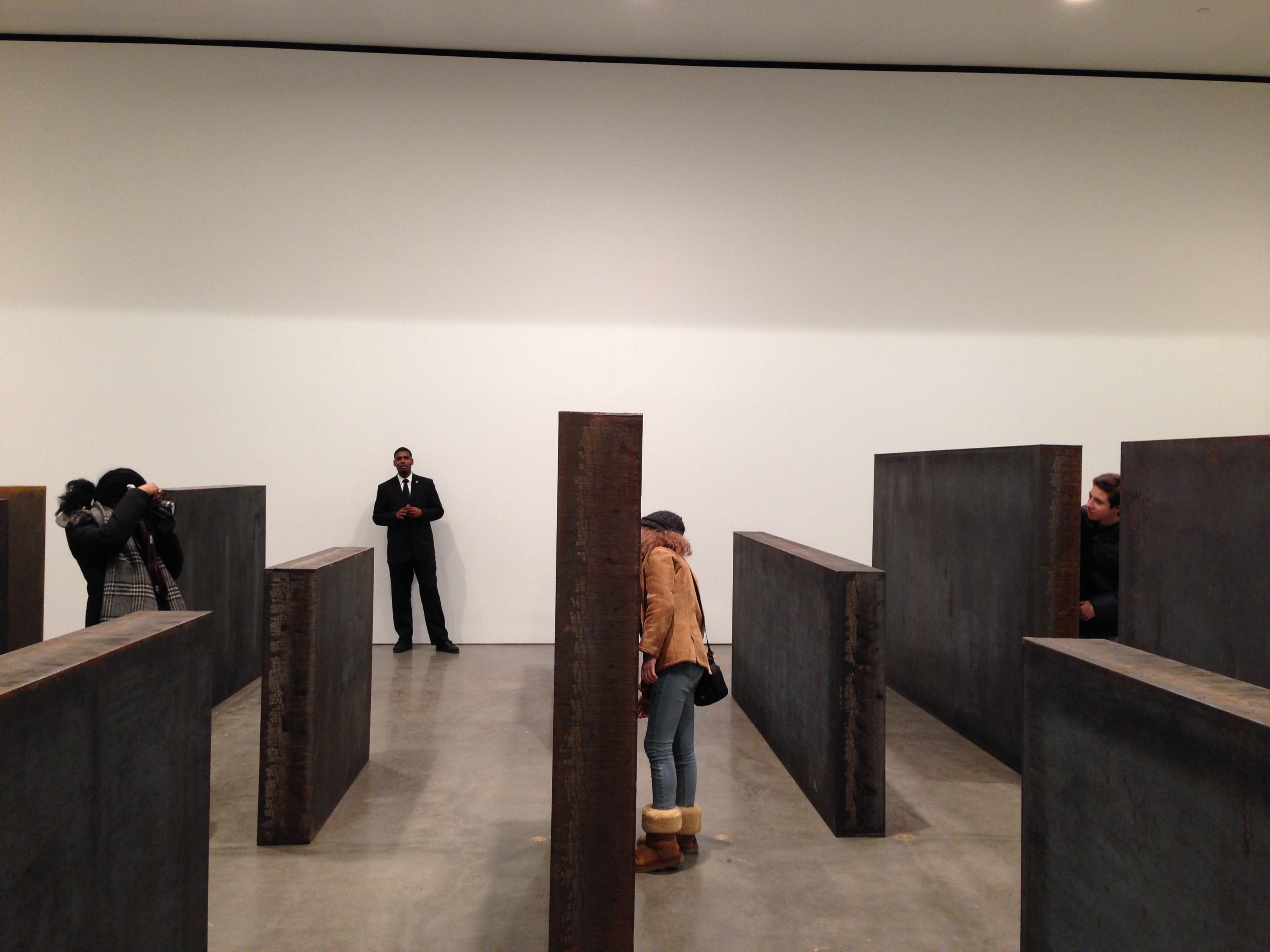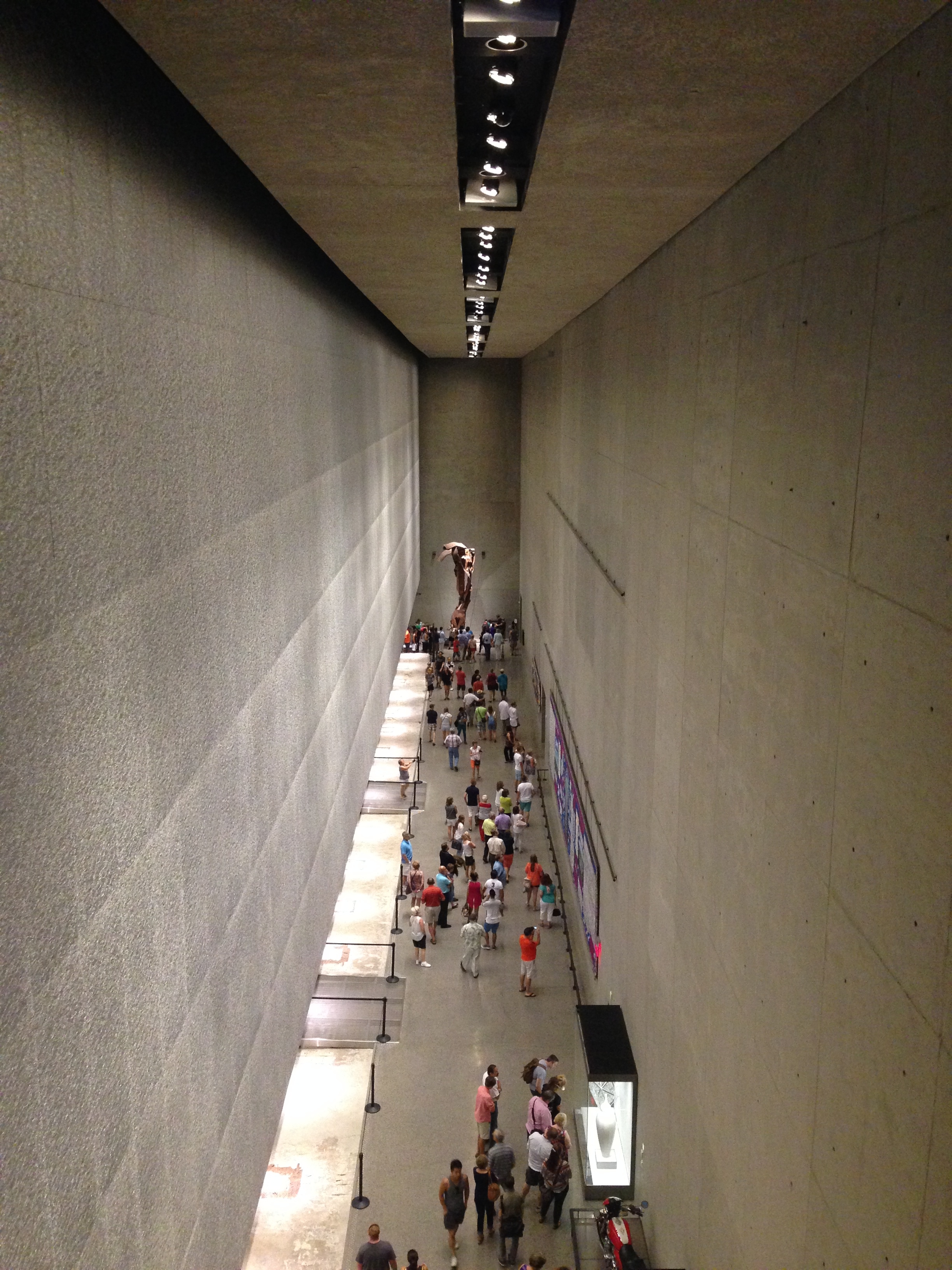The typical summer Saturday in lower Manhattan is a singular New York experience: throngs of tourists ambling through the streets with their heads cocked to the sky, locals shuffling among them in a narcissistic rage, and a strong contingent of the City’s Finest projecting their hallmark mix of unhelpful authority, boredom, and indifference. It seems to matter little that this familiar scene plays out within the blocks surrounding and immediate site of the National September 11 Memorial and Museum, a supposed site of collective sanctity and suffering—a place christened “Hallowed Ground” by the likes of Katie Couric and Barack Obama.1
The opening of the memorial museum on May 21 of this year culminated nearly thirteen years of political infighting, clashing egos, and financial acrobatics, along with a design and construction process that can easily be described with similarly unflattering terms. From around the time of, say, September 12, 2001, the design and development of those sacred sixteen acres has been the centerpiece of a confounding tragedy that quickly turned to farce.
For those who do care, the last decade-plus following the initial design competitions has been a debacle of the highest order. Highlights include the incessant bickering between Daniel Libeskind (World Trade Center site master plan architect and no stranger to the Architecture of Tragedy Remembrance), Larry Silverstein (WTC lease owner), David Childs (chairman of Skidmore, Owings, and Merrill; and Silverstein’s architect of choice), and the Lower Manhattan Development Corporation (a multilevel pseudo-governmental conglomeration created to oversee the entire project); Michael Arad’s bloated budget and frosty relationship with the LMDC, survivor families, and just about everyone else; and Santiago Calatrava’s almost comical disaster that will, at some point, be the nearly $4 billion World Trade Center Transportation Hub. Not to mention the LMDC itself, the Downtown Design Partnership, the Port Authority, or the various mayors, governors, politicians, and families who, at times, waded into the morass.2
After all this, the opening of the Memorial Museum marks the WTC site as the latest node in the city’s tourist circuit and, at least in theory, a public space—something that many commentators have noted, the original Twin Tower plaza, with its impenetrable street walls, was not. The nearly three-year lag between the opening of the memorial and the museum left the site a confusing patchwork of pathways completely cut off from the city by a single, ticketed entrance and airport-like security; it was surrounded by a dense thicket of fences, Jersey barriers, and surveillance infrastructure. While the memorial and museum site is still guarded by Port Authority Police booths, NYPD police officers, bollards of various types and sizes, a couple hundred security cameras, and several heavy steel gates, the site is open to the public. Tickets, pre-registration, or screening no longer required.

Yet while the memorial grounds are technically open to the public, they are heavily regulated. “Prohibited behavior includes, but is not limited to,” demonstrations, loitering, smoking, skateboarding, or “expressive activity that has the effect, intent, or propensity to draw a crowd.” Commercial filming and photography is, of course, banned as well, but that should not be understood as a call for visitors to resist their smartphones or other personal recording devices.

The WTC memorial grounds and Arad’s endless pools are the perfect background for family photos, selfies, Instagrams, tweets, check-ins, and other social media posts. The immensely scaled and uniquely un-Manhattan-like void presents itself as a dramatic tourist destination. It is the antithesis of Times Square, with the memorial and museum acting as the theaters and the visitors performing the act of remembrance, or at the very least, presence, and immediately uploading the experience to prove it.
Like other contemporary monuments of popular urban culture—e.g., Richard Serra at Gagosian, or Kara Walker’s A Subtlety, among countless others—the memorial and museum are designed to be consumed through a screen and broadcast around the world in pixels and bytes, hashtags and “likes.”3 The act of sharing the memorial experience is critical in this formulation not because it allows the site to be read as a digital commodity, but because it is a metric of proof that states: “Yes we are here. Yes we remember.”

Should you be stumped in creating the perfect hashtag, or confused about how to link your photos to Pinterest, the memorial has created a convenient Guide to Commemorate in Your Online Community, with official hashtags, and how-tos for all the most popular social media applications and websites.4 There is even a convenient “Sample Blog Post Template” (“THIS SEPTEMBER 11: HONOR, REMEMBER, REUNITE”). Simply cut and paste the full article, complete with links to the memorial mission statement and preformatted thanks to our nation’s military.5
It has often been claimed that the attacks of September 11 were the most recorded and publicized events in history. It’s hard to know whether or not this is true, but it’s certain that with the proliferation of smartphones and other digital recording devices, that record is being challenged on an almost daily basis (see other media events turned cultural signifiers: the protracted [and so-called “Twitter”] revolution and counterrevolution in Egypt or perhaps Miley Cyrus “Twerking”). A more vexing question that the museum fails to answer would be: With so much visual and media physical ephemera created around a single event, why bother remembering it in something as pathetically slow, solid, and institutional as architecture?
For instance, MSNBC chooses to remember each September 11 by playing its entire news coverage from the day in full starting from the time of the first attack. This spectacle of death-in-real-time, is at once completely mesmerizing and repulsively stomach-churning. Yet listening to Matt Lauer’s stunned silence as United Flight 175 slams into the South Tower is enough to make even the most hardened critic of what 9/11 has become remember what, for one day, it was.
It is clear from the first descent into the Memorial Museum that it was not designed as a place of solemn remembrance, regardless of what the marketing materials say to the contrary.6 The museum is an immersive media environment that attempts to force a specific type of remembrance through a highly constructed narrative, built on the repetition of form and content, and displayed within well-established architectural tropes.

The museum itself is a slightly uncomfortable marriage of form between the Snøhetta-designed entry pavilion and the museum proper, designed by Davis, Brody, Bond. The pavilion is a crystalline shell containing a café and a security maze with stairs descending to the first level below grade where the gift shop, restrooms, and information kiosk are located. Along the stairs are two of Minoru Yamasaki’s still elegant structural steel columns salvaged from the tower wreckage. The two columns appear Serra-esque; huge, rough, and rusted. They are architectural totems abstracted from their structural duties by way of museum installation.
As a diagram, the museum is elegant. A dimly lit walkway threads its way around the reflecting pools and lands on the original tower foundation. Along the way visitors are treated to views of the now-famous slurry wall and foundation floor, scattered with building elements, rescue vehicles, and other heaps of twisted metal. The interior spaces are surprisingly vast and dramatically lit.
The pools themselves are a constant presence within the underground chamber. You are always between them or below them. Often they reveal themselves simply as walls, clad in foamed aluminum panels, at other times they are called upon to conjure the presence of the departed towers. The sheer presence of the slurry wall is perhaps the most powerful reminder of what a dramatic undertaking the original design and construction of the towers was, and how their violent collapse could never quite erase the engineering required to bring them to life. Descending 70 feet below grade reinforces the geologic scale of the WTC. The act of architecture is all that remains, an edifice turned into landscape.
The haptic quality of the slurry walls and tower foundations along with the metallic skin of the pools provides an expected solution to the question of how to create a space for remembrance. It is dark, open, and quiet; all the things we are told memorials should be, all metaphors rendered explicit. This raises the question about the role of a museum within—or as—a site of remembrance.
The museum is not a memorial even if the two are linked in both name and content. In practice, if not effect, they remain typologically and strategically different. Although the museum is fluent in the tectonic language of “memorial,” by claiming space as a museum we are meant to understand its mission as somehow different from that of remembrance. Even the most banal definition of a museum understands it to be a space where objects are on display in order to frame a narrative or propose a history. If we accept this definition, the right to contest those histories, narratives, and objects remains inherently within a museum’s purview. To conflate the two spaces of memorial and museum serves not to blur the lines between the two but to fully subsume the museum objective within that of the memorial.
The effects of this are most apparent when the curatorial voice steps in and speaks for the exhibited objects.7 The area around the slurry wall and space connecting the two pools is an open floor filled with various detritus salvaged from the rescue and cleanup. There are full-size fire trucks, elevator engines, steel columns, stairwells, and other pieces of building and mechanical wreckage presented as both museum object and sacred body. Many objects immediately evoke John Chamberlain’s car sculptures, which only underscore the well-established form and irresistible beauty of destroyed objects as objects of desire.
It’s possible that the objects could productively straddle the line between useless junk, conceptual art, and religious icon; yet the curatorial ambition tends to force an explanation as to exactly what the stairwell or fire engine is supposed to mean. At each instance the nuanced sublime evoked by a dramatic object presented within the cavernous chamber is paired with a ham-fisted caption, explanatory photo, or combination of the two that only serves to reveal a narrative scrubbed clean by both lawyers and marketing executives.
Damien Hirst claimed the attacks on September 11 were “kind of an artwork.”8 By institutionalizing both objects and media from that day within a display space guided by the curatorial logic of art viewership, the museum makes it almost possible to productively fulfill this claim. But missing from this space is the quintessential “museum experience” that produces objects and agendas for multiple perspectives and interpretive readings. Hirst was commenting on the “visually stunning” character of the attacks. Who could argue with him? The effect of watching buildings collapse, smoke billow, and panic ensue from the comfort of our home while news broadcasters grasp for descriptive vocabulary is not just visually stunning, but completely engrossing. The visual material generated from the attacks still stands as a collective appreciation for the aesthetics of violent destruction that were instantly broadcast and repeated ad nauseam around the globe.
Entering the main exhibition space—shimmied underneath the reflecting pools and arranged into a conventional exhibition layout—the visual effects Hirst describe are brought into sharp relief through the installation of “In Memoriam,” the museum’s inaugural (and perhaps only) exhibition. The exhibition is the only place in the museum where cellphones are not allowed, likely to protect the recordings of victims, aid workers, reporters, and bystanders that play on endless loops through the exhibition. Beginning with newspaper clippings and weather reports from the day in question and ending with photos of American troops in Iraq, the exhibition is an onslaught of images, video, audio, and dust-covered tchotchkes. The choreography of the exhibition is timed to cover one twenty-four-hour period footnoted with items like Ronald Reagan funding the militias that later became al Qaeda, the global antiwar movement leading up the Iraq war, the USA PATRIOT Act, and Guantanamo Bay. The final exclamation point on the day reminds us to honor our troops.
This stands as a pointed contrast to other museums established to commemorate horrific events. The Hiroshima Peace Memorial Museum makes claims on our collective humanity and stands as a clarion call against nuclear weapons. Likewise, the world’s Holocaust museums identify the terrifying reality that the tendency toward totalitarian and genocidal indifference are universal traits. This memorial museum stands as a reminder of the problematic dichotomies established in the wake of the attacks. The pervasive message tying the exhibition themes together is not a universal projection of suffering, innocence, or values but one of American uniqueness articulated best by President Bush ten days after the attack: “Either you are with us, or you are with the terrorists.”9
Removing yourself from the immediate experience of the crowded gallery, it’s possible to mistake the installation as an art school rendition of political art trying to capitalize on shock value over content. Video footage of planes barreling into the towers and desperate workers leaping to their deaths endlessly play on video loops. Likewise for the voicemail messages left by terrified airline passengers. The galleries are filled with newspapers, scraps of paper, photos, ID cards, uniforms, more misshapen metal things, old shoes, President Bush’s megaphone, etc. The horde of material and media takes the sharp point of the day’s events and presents them as a texture, a dull fear. It feels as if the full brunt of the most recorded event in history is brought to bear on each viewer, all within a couple hundred feet of exhibition space. The visual-sonic barrage at one time leaves nothing out yet presents nothing important enough to remember.
If we take Dick Cheney’s axiom that “9/11 changed everything,” how, then, is it possible to take the events of that day and simply present them as things that happened?10 While the museum skirts this question, it attempts to construct and answer another one: What happens when a whole generation of people live in a world that is somehow changed forever (“from” and “to what” being unimportant) yet lack knowledge of the one thing that changed it?
What has undoubtedly changed in the last thirteen years is the nature of media dissemination and consumption. The museum deploys these techniques to the maximum potential and lowest common denominator. Formally, the video loops speak the same language as a six-second Vine or an animated GIF and their shocking content would be at home linked from the Huffington Post or Drudge Report. Which is to say, the museum doesn’t feel so different from what you might get from a “September 11” Google search, or the experience of Your Actual Life juggling texts, blogs, email, YouTube, food photos, and emoji—with work crammed in there somewhere.
The problem the museum faces is not remembrance but attention. With instant access to countless photos, videos, facts, and figures, the museum doubles down on the explicit content, not in an attempt at remembrance but in an attempt to swipe a tiny bit of attention from the perennially distracted viewer. The underlying theme of such frantic attention-seeking becomes more clear: If September 11 is remembered as anything other than a tragedy perpetrated on innocent Americans by a group of fanatical Muslims, how are we to explain our country’s actions over the past thirteen years? This is not necessarily a rhetorical question. The struggle to define the meaning of September 11 is not an abstraction—it has been the defining center of American culture, politics, and foreign policy for half a generation. The events of September 11 remain a shaky cornerstone of contemporary American life. At the very least, the attacks were immediately capitalized upon to enact sweeping changes in American foreign and domestic policy. The endless war, torture, surveillance, intensely polarized populace, and completely dysfunctional government that currently define America can, in their own unique ways, be rooted in that sunny September day. And thus, among the myriad tragedies of the day, the various social and political consequences enacted in its honor can’t be so easily ignored.
The memorial and museum were created under the explicit auspices of remembrance but are uniquely presented within a culture in which nothing is either forgotten or remembered. By solidifying the most solipsistic version of 9/11, the museum does little in the way of contributing to the cultural or political landscape it intends to exist within. It only serves to reiterate and redistribute content to a public too distracted to truly care.
-
For more on the term hallowed ground, and its use to describe the World Trade Center site, see Jack Shafer’s “Nobody Owns 9/11,” Slate, (September 10, 2012) slate.com/articles/news_and_politics/press_box/2010/09/nobody_owns_911.html. ↩
-
See Joe Hagan’s “The Breaking of Michael Arad,” New York, (May 22, 2006) nymag.com/arts/architecture/features/17015. ↩
-
As of October 2, 8:20 a.m., there are 95,714 images on Instagram linked to the #911Memorial. ↩
-
911memorial.org/sites/all/files/2012_Commemorate_Online_0.pdf ↩
-
A Google search for the sample blog post headline yielded “about 3,650” results. ↩
-
The museum’s stated mission “…is to bear solemn witness to the terrorist attacks of September 11, 2001, and February 26, 1993. The museum honors the nearly 3,000 victims of these attacks and all those who risked their lives to save others. It further recognizes the thousands who survived and all who demonstrated extraordinary compassion in the aftermath. …” 911memorial.org/mission. ↩
-
Chief curator Jan Ramirez was appointed in 2004. The museum director is former assistant director of the Holocaust Museum Alice M. Greenwald, who was appointed in 2006. ↩
-
Bush made this claim in a speech in front of Congress on September 20, 2001. Similar phrases have been uttered by V.I. Lenin Benito Mussolini. ↩
-
nbcnews.com/id/3080244/ns/meet_the_press/t/transcript-sept. ↩
Jordan Carver is the 2014–2015 Banham Fellow at the University at Buffalo, a co-organizer of Who Builds Your Architecture? and an editor of the Avery Review.

